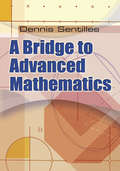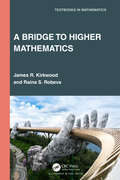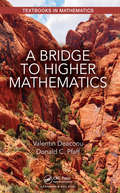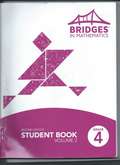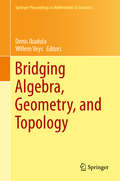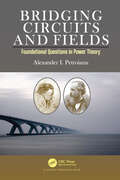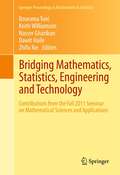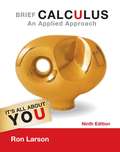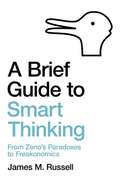- Table View
- List View
A Bridge to Advanced Mathematics
by Dennis SentillesThis helpful "bridge" book offers students the foundations they need to understand advanced mathematics, spanning the gap between practically oriented and theoretically orientated courses. Part 1 provides the most basic tools, examples, and motivation for the manner, method, and material of higher mathematics. Part 2 covers sets, relations, functions, infinite sets, and mathematical proofs and reasoning. 1975 edition.
A Bridge to Higher Mathematics (Textbooks in Mathematics)
by James R. Kirkwood Raina S. RobevaThe goal of this unique text is to provide an “experience” that would facilitate a better transition for mathematics majors to the advanced proof-based courses required for their major.If you feel like you love mathematics but hate proofs, this book is for you. The change from example-based courses such as Introductory Calculus to the proof-based courses in the major is often abrupt, and some students are left with the unpleasant feeling that a subject they loved has turned into material they find hard to understand.The book exposes students and readers to some fundamental content and essential methods of constructing mathematical proofs in the context of four main courses required for the mathematics major – probability, linear algebra, real analysis, and abstract algebra.Following an optional foundational chapter on background material, four short chapters, each focusing on a particular course, provide a slow-paced but rigorous introduction. Students get a preview of the discipline, its focus, language, mathematical objects of interest, and methods of proof commonly used in the field. The organization of the book helps to focus on the specific methods of proof and main ideas that will be emphasized in each of the courses.The text may also be used as a review tool at the end of each course and for readers who want to learn the language and scope of the broad disciplines of linear algebra, abstract algebra, real analysis, and probability, before transitioning to these courses.
A Bridge to Higher Mathematics (Textbooks in Mathematics #43)
by Donald C. Pfaff Valentin DeaconuA Bridge to Higher Mathematics is more than simply another book to aid the transition to advanced mathematics. The authors intend to assist students in developing a deeper understanding of mathematics and mathematical thought. The only way to understand mathematics is by doing mathematics. The reader will learn the language of axioms and theorems and will write convincing and cogent proofs using quantifiers. Students will solve many puzzles and encounter some mysteries and challenging problems. The emphasis is on proof. To progress towards mathematical maturity, it is necessary to be trained in two aspects: the ability to read and understand a proof and the ability to write a proof. The journey begins with elements of logic and techniques of proof, then with elementary set theory, relations and functions. Peano axioms for positive integers and for natural numbers follow, in particular mathematical and other forms of induction. Next is the construction of integers including some elementary number theory. The notions of finite and infinite sets, cardinality of counting techniques and combinatorics illustrate more techniques of proof. For more advanced readers, the text concludes with sets of rational numbers, the set of reals and the set of complex numbers. Topics, like Zorn’s lemma and the axiom of choice are included. More challenging problems are marked with a star. All these materials are optional, depending on the instructor and the goals of the course.
Bridges in Mathematics: Student Book, Volume 1
by The Math Learning CenterBridges to Mathematics, Student Book, Grade 4, Volume 1, Second Edition
Bridges in Mathematics: Student Book, Volume 2
by The Math Learning CenterBridges in Mathematics is a standards-based K-5 curriculum that provides a unique blend of concept development and skills practice in the context of problem solving. It incorporates the Number Corner, a collection of daily skill-building activities for students.
Bridges in Mathematics, Grade 2, Student Book, Spanish Edition
by The Math Learning CenterNIMAC-sourced textbook
Bridges in Mathematics, Grade 4: Student Book, Volumes 1 and 2
by The Math Learning CenterNIMAC-sourced textbook
Bridges in Mathematics, Grade 4, Home Connections
by The Math Learning CenterNIMAC-sourced textbook
Bridges in Mathematics, Grade 4, Student Book, Volume 1
by The Math Learning CenterNIMAC-sourced textbook
Bridges in Mathematics, Home Connections, Grade 2
by The Math Learning CenterNIMAC-sourced textbook
Bridges in Mathematics, Home Connections, Grade 2, Volume 1, Spanish Edition
by The Math Learning CenterNIMAC-sourced textbook
Bridges in Mathematics, Home Connections, Grade 2, Volume 2, Spanish Edition
by The Math Learning CenterNIMAC-sourced textbook
Bridges in Mathematics, Home Connections, Grade 3
by The Math Learning CenterNIMAC-sourced textbook
Bridges in Mathematics, Home Connections, Grade 5
by The Math Learning CenterNIMAC-sourced textbook
Bridges to Algebra and Geometry: Mathematics in Context (2nd Edition)
by Cord CommunicationsSuccessful people apply the skills of problem solving in many areas of life. Mathematics helps you solve problems and think logically. Many times you need to assemble facts and use addition, subtraction, multiplication, or division to solve a particular problem.
Bridging Algebra, Geometry, and Topology (Springer Proceedings in Mathematics & Statistics #96)
by Denis Ibadula Willem VeysAlgebra, geometry and topology cover a variety of different, but intimately related research fields in modern mathematics. This book focuses on specific aspects of this interaction. The present volume contains refereed papers which were presented at the International Conference "Experimental and Theoretical Methods in Algebra, Geometry and Topology", held in Eforie Nord (near Constanta), Romania, during 20-25 June 2013. The conference was devoted to the 60th anniversary of the distinguished Romanian mathematicians Alexandru Dimca and Ştefan Papadima. The selected papers consist of original research work and a survey paper. They are intended for a large audience, including researchers and graduate students interested in algebraic geometry, combinatorics, topology, hyperplane arrangements and commutative algebra. The papers are written by well-known experts from different fields of mathematics, affiliated to universities from all over the word, they cover a broad range of topics and explore the research frontiers of a wide variety of contemporary problems of modern mathematics.
Bridging Circuits and Fields: Foundational Questions in Power Theory
by Alexander I. PetroianuEnergy and power are fundamental concepts in electromagnetism and circuit theory, as well as in optics, signal processing, power engineering, electrical machines, and power electronics. However, in crossing the disciplinary borders, we encounter understanding difficulties due to (1) the many possible mathematical representations of the same physical objects, and (2) the many possible physical interpretations of the same mathematical entities. The monograph proposes a quantum and a relativistic approach to electromagnetic power theory that is based on recent advances in physics and mathematics. The book takes a fresh look at old debates related to the significance of the Poynting theorem and the interpretation of reactive power. Reformulated in the mathematical language of geometric algebra, the new expression of electromagnetic power reflects the laws of conservation of energy-momentum in fields and circuits. The monograph offers a mathematically consistent and a physically coherent interpretation of the power concept and of the mechanism of power transmission at the subatomic (mesoscopic) level. The monograph proves (paraphrasing Heaviside) that there is no finality in the development of a vibrant discipline: power theory.
Bridging Mathematics, Statistics, Engineering and Technology: Contributions from the Fall 2011 Seminar on Mathematical Sciences and Applications (Springer Proceedings in Mathematics & Statistics #24)
by Bourama Toni Dawit Haile Keith Williamson Nasser Ghariban Zhifu XieThis volume contains the invited contributions from talks delivered in the Fall 2011 series of the Seminar on Mathematical Sciences and Applications 2011 at Virginia State University. Contributors to this volume, who are leading researchers in their fields, present their work in a way to generate genuine interdisciplinary interaction. Thus all articles therein are selective, self-contained, and are pedagogically exposed and help to foster student interest in science, technology, engineering and mathematics and to stimulate graduate and undergraduate research and collaboration between researchers in different areas. This work is suitable for both students and researchers in a variety of interdisciplinary fields namely, mathematics as it applies to engineering, physical-chemistry, nanotechnology, life sciences, computer science, finance, economics, and game theory.
Brief Calculus: An Applied Approach
by Ron LarsonDesigned specifically for business, economics, or life/social sciences majors, BRIEF CALCULUS: AN APPLIED APPROACH, Ninth Edition, motivates students while fostering understanding and mastery. The book emphasizes integrated and engaging applications that show students the real-world relevance of topics and concepts. Applied problems drawn from government sources, industry, current events, and other disciplines provide well-rounded examples and appeal to students' diverse interests. The Ninth Edition builds upon its applications emphasis through updated exercises and relevant examples. Pedagogical features--from algebra review to study tips--provide extra guidance and practice.
Brief Calculus: An Applied Approach (Ninth Edition)
by Ron LarsonDesigned specifically for business, economics, or life/social sciences majors, BRIEF CALCULUS: AN APPLIED APPROACH, Ninth Edition, motivates students while fostering understanding and mastery. The book emphasizes integrated and engaging applications that show students the real-world relevance of topics and concepts. Applied problems drawn from government sources, industry, current events, and other disciplines provide well-rounded examples and appeal to students' diverse interests. The Ninth Edition builds upon its applications emphasis through updated exercises and relevant examples. Pedagogical features--from algebra review to study tips--provide extra guidance and practice.
A Brief Guide to Smart Thinking: From Zeno’s Paradoxes to Freakonomics
by James M. RussellEach book is summarised to convey a brief idea of what each one has to offer the interested reader, while a 'Speed Read' for each book delivers a quick sense of what each book is like to read and a highly compressed summary of the main points of the book in question. The titles covered include thought-provoking classics on psychology, mindfulness, rationality, the brain, mathematical and economic thought and practical philosophy. The selection includes books about self-improvement as well as historically interesting accounts of how the mind works. Titles included go back as far as the Epictetus classic The Enchiridion and Bertrand Russell's charming The ABC of Relativity, and proceed through classics such as Edward de Bono's Lateral Thinking and into the digital era with titles such as The Shallows and Big Data. The books are arranged chronologically, which draws attention to some of the interesting juxtapositions and connections between them. Some of the titles included are: Freakonomics, by Steven D. Levitt; Blink: The Power of Thinking Without Thinking, by Malcolm Gladwell; Sapiens: A Brief History of Humankind, by Yuval Noah Harari; The Organized Mind: Thinking Straight in the Age of Information Overload, by Daniel J. Levitin; The Descent of Man, by Grayson Perry; How the Mind Works, by Steven Pinker; Black Box Thinking: Why Some People Never Learn from Their Mistakes - But Some Do, by Matthew Syed; We Should All Be Feminists, by Chimamanda Ngozi Adichie; Guns, Germs, and Steel: The Fates of Human Societies, by Jared Diamond; The Black Swan: The Impact of the Highly Improbable, by Nassim Nicholas Taleb; Man's Search for Meaning, by Viktor E. Frankl; The News: A User's Manual, by Alain de Botton; Mindware: Tools for Smart Thinking, by Richard E. Nisbett; The ABC of Relativity, by Bertrand Russell; The Psychopath Test, by Jon Ronson; The Path: What Chinese Philosophers Can Teach Us About the Good Life, by Michael Puett; A Brief History of Time, by Stephen Hawking; Messy: The Power of Disorder to Transform Our Lives, by Tim Harford; Big Data: A Revolution That Will Transform How We Live, Work, and Think, by Viktor Mayer-Schönberger; Moneyball: The Art of Winning an Unfair Game, by Michael Lewis; The Survivors Club: The Secrets and Science That Could Save Your Life, by Ben Sherwood; Black Box Thinking, by Matthew Syed; Chaos: Making a New Science, by James Gleick; A Short History of Nearly Everything, by Bill Bryson; The Shallows: What the Internet Is Doing to Our Brains, by Nicholas Carr; Making Ideas Happen: Overcoming the Obstacles Between Vision and Reality, by Scott Belsky; The Enchiridion, by Epictetus; Gödel, Escher, Bach, by Douglas R. Hofstadter; What I Talk About When I Talk About Running, by Haruki Murakami; and Lateral Thinking, by Edward de Bono.
A Brief Guide to Smart Thinking: From Zeno's Paradoxes to Freakonomics
by James M. RussellEach book is summarised to convey a brief idea of what each one has to offer the interested reader, while a 'Speed Read' for each book delivers a quick sense of what each book is like to read and a highly compressed summary of the main points of the book in question. The titles covered include thought-provoking classics on psychology, mindfulness, rationality, the brain, mathematical and economic thought and practical philosophy. The selection includes books about self-improvement as well as historically interesting accounts of how the mind works. Titles included go back as far as the Epictetus classic TheEnchiridion and Bertrand Russell's charming TheABC of Relativity, and proceed through classics such as Edward de Bono's Lateral Thinking and into the digital era with titles such as The Shallows and Big Data. The books are arranged chronologically, which draws attention to some of the interesting juxtapositions and connections between them. Some of the titles included are: Freakonomics, by Steven D. Levitt; Blink: The Power of Thinking Without Thinking, by Malcolm Gladwell; Sapiens: A Brief History of Humankind, by Yuval Noah Harari; The Organized Mind: Thinking Straight in the Age of Information Overload, by Daniel J. Levitin; The Descent of Man, by Grayson Perry; How the Mind Works, by Steven Pinker; Black Box Thinking: Why Some People Never Learn from Their Mistakes - But Some Do, by Matthew Syed; We Should All Be Feminists, by Chimamanda Ngozi Adichie; Guns, Germs, and Steel: The Fates of Human Societies, by Jared Diamond; The Black Swan: The Impact of the Highly Improbable, by Nassim Nicholas Taleb; Man's Search for Meaning, by Viktor E. Frankl; The News: A User's Manual, by Alain de Botton; Mindware: Tools for Smart Thinking, by Richard E. Nisbett; The ABC of Relativity, by Bertrand Russell; The Psychopath Test, by Jon Ronson; The Path: What Chinese Philosophers Can Teach Us About the Good Life, by Michael Puett; A Brief History of Time, by Stephen Hawking; Messy: The Power of Disorder to Transform Our Lives, by Tim Harford; Big Data: A Revolution That Will Transform How We Live, Work, and Think, by Viktor Mayer-Schönberger; Moneyball: The Art of Winning an Unfair Game, by Michael Lewis; The Survivors Club: The Secrets and Science That Could Save Your Life, by Ben Sherwood; Black Box Thinking, by Matthew Syed; Chaos: Making a New Science, by James Gleick; A Short History of Nearly Everything, by Bill Bryson; The Shallows: What the Internet Is Doing to Our Brains, by Nicholas Carr; Making Ideas Happen: Overcoming the Obstacles Between Vision and Reality, by Scott Belsky; The Enchiridion, by Epictetus; Gödel, Escher, Bach, by Douglas R. Hofstadter; What I Talk About When I Talk About Running, by Haruki Murakami; and Lateral Thinking, by Edward de Bono.
